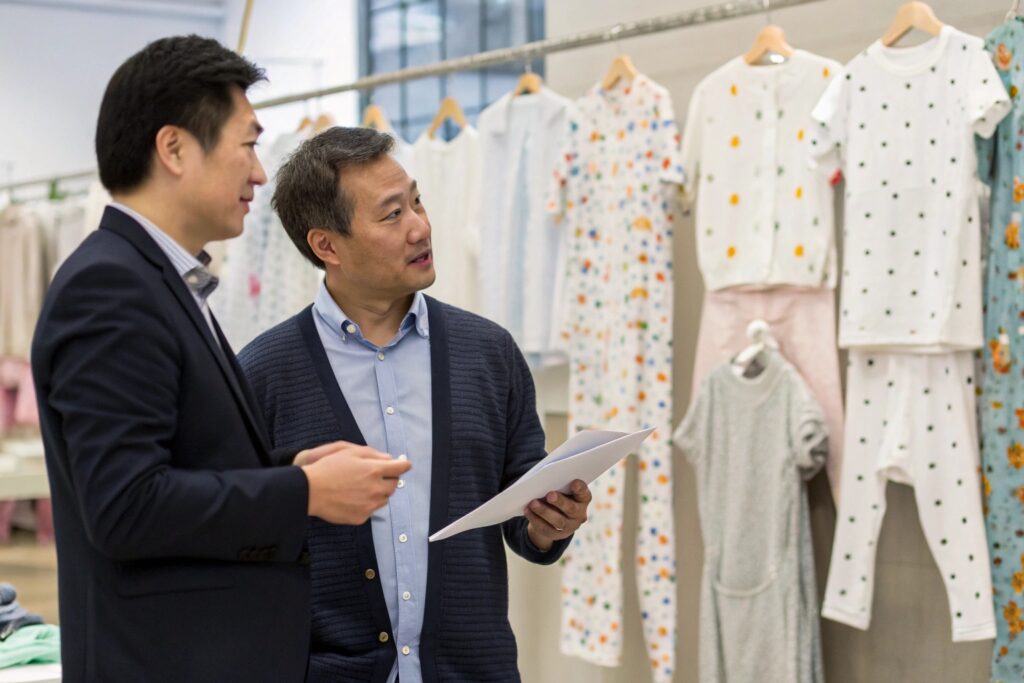U.S. tariffs on imported apparel—especially from China—can drive up costs fast. For kidswear brands and buyers, that means tighter margins and higher risks.
To save on kids’ clothing despite tariffs, use smart trade strategies, source from low-duty regions, negotiate better deals, and optimize bulk shipping.
Here’s how to keep your kidswear business profitable—even when tariffs get in the way.
What Trade Strategies Help Offset Tariff Costs?
Tariffs may be unavoidable, but their impact can be reduced with the right sourcing and financial planning.
Use trade programs, alternative sourcing models, and strategic logistics to minimize the financial impact of U.S. tariffs on imported kidswear.

What trade programs help reduce tariff exposure?
Consider these options:
| Trade Program | How It Helps |
|---|---|
| USMCA (US, Mexico, Canada) | Duty-free under certain origin rules |
| FTA Countries (e.g., Vietnam) | Lower tariff rates with certificate of origin |
| First-Sale Rule | Reduces duty by declaring the price at first sale (e.g., factory → middleman → buyer) |
| Generalized System of Preferences (GSP) | Not currently active, but worth watching |
| Section 321 De Minimis | Exempts imports under $800 (used in DTC dropshipping) |
Many of our clients at Fumao use the First-Sale Rule to lower dutiable value—especially when buying through agents or trading companies.
Can switching incoterms help reduce costs?
Yes. Choose FOB or DDP based on your control and risk appetite:
- FOB (Free on Board) – You manage freight, customs, and duty
- DDP (Delivered Duty Paid) – Supplier handles import fees (price includes tariffs)
We offer DDP shipping so clients can avoid surprise fees and plan total landed costs clearly in advance.
How to Find Kidswear Suppliers Outside High-Tariff Zones?
China still leads in kidswear manufacturing—but sourcing from lower-tariff countries can cut import costs significantly.
Look beyond China to countries like Vietnam, Bangladesh, and Central America, which often enjoy lower duties and strong kidswear production capacity.

Which countries offer reliable kidswear production with lower tariffs?
Here’s a sourcing comparison:
| Country | Tariff Rate to U.S. | Key Advantages |
|---|---|---|
| Vietnam | 8–12% (lower for FTA items) | Strong knitwear + woven factories |
| Bangladesh | 0–16% (cheap labor) | Great for basics, babywear, sets |
| India | 5–18% (varies by HS code) | Skilled in cotton and handwork |
| Mexico | 0% (USMCA) | Nearshoring option, faster delivery |
| Cambodia | 0–16% | Low-cost labor, growing babywear exports |
Fumao sources OEKO-TEX® certified fabrics from Vietnam and Bangladesh to help clients build compliant, cost-effective collections.
What should you consider when sourcing outside China?
- Factory certifications (CPSIA, OEKO-TEX®, BSCI)
- Language and communication ease
- Production timelines (can be longer than China)
- Political stability and shipping port access
- Compliance with U.S. safety laws for babywear
Even if you still use China, consider dual-sourcing to reduce risk and exposure.
Tips for Negotiating Better Deals with Manufacturers?
Tariffs cut into your margin—so you need to find savings elsewhere. Smart negotiation helps you control costs without cutting corners.
Negotiate better pricing, payment terms, and service packages with your manufacturer to protect your margins against tariff impact.

What can you negotiate to save money?
| Cost Area | Negotiation Strategy |
|---|---|
| Unit Price | Order slightly higher quantity or simplify trims |
| Packaging | Use factory’s standard options or bulk pack |
| Sampling Fees | Ask for sample fee credit after bulk approval |
| Labeling & Tags | Combine sourcing with factory’s supplier list |
| Shipping Terms | Bundle with other buyers for DDP or better rates |
At Fumao, we often offer free re-sampling after style confirmation, and bulk discounts for clients who simplify color or fabric choices across SKUs.
How to ask for a better deal respectfully?
- Show that you plan to reorder (even in small batches)
- Be specific: “Can we reduce the cost by removing this snap detail?”
- Don’t rush—build a relationship with the production team
- Bundle multiple styles or POs for a consolidated quote
Remember: You’re not just buying products—you’re building a partnership.
How Bulk Ordering and Consolidated Shipping Reduce Expenses?
Tariffs are charged by value—but shipping and per-unit costs drop with scale. Smart logistics help you offset higher import duties.
Placing bulk orders and consolidating shipments can reduce per-unit costs, freight fees, and customs clearance expenses.

How does bulk ordering help save money?
| Strategy | How It Saves |
|---|---|
| Larger production run | Reduces per-unit sewing and cutting costs |
| Bulk fabric sourcing | Unlocks supplier discounts |
| Reduced handling fees | Fewer cartons = fewer customs entries |
| Cheaper shipping per piece | Lowers freight and fuel surcharge per unit |
For example, combining 5 SKUs into one 1,200-piece order is more cost-effective than splitting them into 3 separate 400-piece runs.
How can you consolidate shipping to save even more?
- Ship via LCL or FCL sea freight instead of air
- Ask for multi-style cartons to minimize CBM
- Use freight forwarders that offer shared containers
- Choose a factory that handles labeling + polybagging to avoid U.S. labor costs
At Fumao, we help clients create master packing lists and bundle labels for fast customs clearance. One brand saved 18% on landed cost just by switching from air to consolidated sea freight.
Conclusion
Tariffs are a challenge—but not a dealbreaker. With smart sourcing, smart shipping, and strategic negotiation, your kidswear brand can stay profitable, even with higher import fees.










